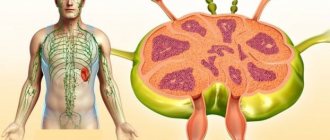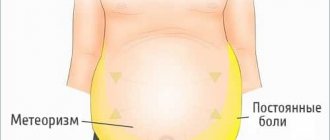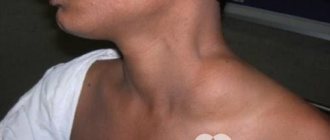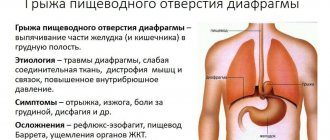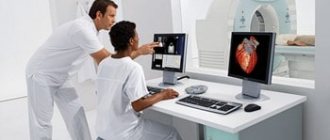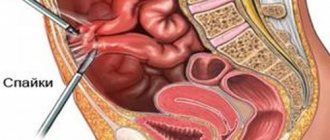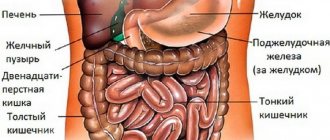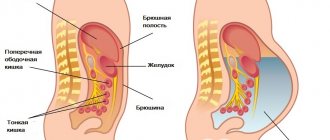Surgery
Share
- What is pathology and the causes of its occurrence?
- Key symptoms to watch out for
- Basic methods for diagnosing the disease
- What treatments are there for the disease?
- Fighting disease using traditional medicine
- Proper nutrition is one of the components of treatment
A postoperative abdominal hernia, which is practically not treated without surgery, is one of the consequences of a previous surgical intervention.
That is, at the site of the scar that remains after the operation, a defective neoplasm (hernia) begins to develop in the abdominal wall. A negative consequence of such a defect is that the hernia also involves part of one of the abdominal organs. There are various names for this pathological process that are used in medical practice:
- postoperative ventral hernia;
- cicatricial.
A scar hernia is one of the negative consequences of surgical intervention, which can manifest itself both in the near future and after a long period of time. Medical statistics show that approximately 7-10% of patients operated on (due to diseases of the internal organs of the abdominal region) seek help with a diagnosis of postoperative hernia in the abdomen.
Causes of pathology
Ventral hernia occurs due to disruption of the wound healing process after surgery. What is it and what's the big deal? Non-healing wounds in humans are rare. But the longer the wound does not heal, the less dense the scar becomes. Five reasons why a postoperative wound heals slowly:
(if the table is not completely visible, scroll to the right)
| Cause | Explanation |
| 1. Infection is the main reason for slow healing | Suppuration of a postoperative wound can lead to the appearance of a ventral hernia in the future. This probability is not very high, but it greatly depends on the patient’s age, the presence of concomitant pathologies and the severity of the infectious inflammation. |
| 2. Failure of the patient to comply with the postoperative regimen | Wound healing begins immediately after the incision is sutured. A more or less dense suture is formed within 7–10 days, and the final formation of the scar ends 6 months after the operation. During this period, the seam must be taken care of, because it is very elastic and can stretch and even burst. Avoid excessive physical activity during this time and wear a brace if necessary. |
| 3. Concomitant diseases | Not only infections, but also some diseases, especially those affecting the microvascular bed (diabetes mellitus, renal and heart failure), can interfere with wound healing. In this category of patients, the sutures from the wound are removed 7 days later, and the period of formation of a dense scar can last up to 1 year. |
| 4. Obesity | Excess fat in the abdominal wall impairs blood circulation in it, which prevents normal wound healing. Also, obesity of the abdominal organs significantly increases intra-abdominal pressure, increasing the load on the postoperative scar. |
| 5. Defects in surgical technique | This cause of ventral protrusion is last on the list, but the human factor cannot be excluded from surgical practice for a long time. This includes: low quality surgical threads, too strong or weak tension of the wound edges, intersection of nerve trunks, etc. |
Intestinal perforation is one of the most serious complications of a ventral hernia. Click on photo to enlarge
What does an incisional hernia look like?
Postoperative hernia is a protrusion of the internal organs of the peritoneum in the area of the postoperative scar due to diastasis of the abdominal muscles.
Sometimes former patients of surgical hospitals, some time after surgery, may notice painful changes in the area of the postoperative scar. This can be a rounded protrusion, ranging in size from a few centimeters in diameter to quite large formations (tens of centimeters).
Postoperative abdominal hernia photo:
The cause may be a postoperative hernia in the abdomen. It appears as a result of diastasis (divergence) of the abdominal muscles, which occurs due to excessive tissue tension after suturing the wound or a number of other reasons.
The resulting holes can get into:
- Intestinal loops and walls;
- Oil seal sections of various sizes.
The timing of the formation of a postoperative hernia can vary: from the early period after surgery to several months and even years. Operations after which a ventral hernia may occur are resections, suturing of gastric ulcers, interventions on the duodenum, gallbladder and bile ducts, intestinal resections or gynecological operations (through an incision in the anterior abdominal wall). This complication requires mandatory consultation with a surgeon and, with timely treatment, is usually corrected quickly enough, without serious consequences for the patient. What is a postoperative hernia and how to get rid of it - this will be discussed in our article.
Why is it that in some cases, after surgery, complete recovery does not occur, but a ventral hernia appears? There are a number of reasons when an inferior (incompetent) scar is formed or the tissue around a postoperative wound cannot fully perform a barrier function:
- inflammation, suppuration of the surgical wound;
- slowing down regeneration (healing) processes - often occurs in patients with diabetes mellitus, patients with severe chronic diseases of the liver, kidneys, etc.;
- increased intra-abdominal pressure (with obesity, with tissue deficiency in the area of the postoperative wound);
- disruption of the innervation of the muscles of the anterior abdominal wall due to accidental intraoperative damage to the nerve trunks. Which leads to paresis and paralysis of muscle areas, they cannot fully perform their functions;
- surgeon errors (inadequate choice of suture material, violation of wound suturing technique, incorrect access to the operated organ);
- violation by patients of the prescribed regimen (starting physical activity too early, non-compliance with the diet, ignoring the requirements for using a bandage).
Surgical treatment
Any hernia can only be treated surgically. Without surgery, protrusions can go away on their own only in children, and not all of them. Postoperative ventral hernia is a direct indication for surgical treatment.
Surgical removal of this type of protrusion has certain difficulties:
- The presence of a large amount of scar tissue from an old operation, which has poor blood supply and creates the ground for recurrence of the hernia.
- Usually these are large protrusions, which creates a lot of problems during surgery.
Two types of surgical techniques for ventral hernias:
- Tension. To close the hernial orifice, the own tissue of the abdominal wall is used.
- Non-tensioned. The hernial orifice is closed using artificial materials.
- Open: a large skin incision is made. The old scar is usually excised (this means that the new scar will be slightly longer than the old one).
- Laparoscopic: the hernia is closed from the inside using a special instrument (laparoscope). This technique is used mainly for small protrusions.
The advantages and disadvantages of both methods are shown in the table:
(if the table is not completely visible, scroll to the right)
| Advantages | Flaws | |
| Tension techniques |
|
|
| Tension-free techniques |
|
|
Today, up to 90% of ventral hernias are removed using tension-free techniques.
Types and causes of appearance
Main reasons:
- tendency to constipation;
- children or old age;
- violation of the anatomical integrity of the anterior abdominal wall due to previous operations;
- hard physical labor;
- male gender;
- tendency towards increased body weight;
- severe coughing or screaming;
- repeated complex natural childbirth;
- injuries.
Hernias of the white line of the abdomen can be congenital or acquired. They rarely reach a diameter of more than 10 cm. More often they are located above the navel and are extremely rarely pinched.
The clinical picture is manifested by pain in the organ that enters the hernial sac. This could be the omentum, loops of the small intestine, or bladder.
If intestinal loops get into the hernial orifice, discomfort occurs. This may be a burning sensation in the loops of intestine in the upper abdomen. In childhood, hernias of the white line practically do not occur.
Treatment without surgery
A ventral hernia cannot be treated without surgery - it is impossible.
Conservative therapy consists of wearing a special bandage that prevents the abdominal organs from protruding under the skin. Wearing a bandage is labor-intensive and inconvenient, so this method is used only when surgery is contraindicated:
- severe general condition of the body;
- elderly and senile age;
- pregnancy;
- cardiac, renal, liver failure;
- patient's refusal to undergo surgery.
Wearing a bandage is a conservative method of treating a ventral hernia
Symptoms of the disease
The main sign of a hernia is a characteristic protrusion in the area of the surgical suture. This protrusion is barely noticeable in the initial period; over time, the area increases.
In the early stages of the development of the disease, the hernia is easily reduced and does not cause any particular inconvenience to the patient. Pain occurs only when lifting heavy objects, sudden movements and bending. But the lack of treatment leads to the growth of the hernia, and over time the pain intensifies.
The following symptoms are added to the protrusion of a hernia:
- Inflammation of the skin in the area of the hernia.
- Increased gas formation.
- Bloating.
- Constipation.
- Blood in stool and urine.
The process of formation of a ventral hernia
Prevention measures
Preventing the formation of postoperative protrusion is easier and cheaper than treating it. To do this you need:
- exercise to keep your muscles in good shape;
- fight excess weight;
- Eat rationally and avoid constipation.
Also, after any abdominal surgery it is necessary to:
- follow the recommendations of the attending surgeon;
- do not expose yourself to excessive physical activity for 6 months after the intervention;
- if necessary, wear a bandage for prevention.
Treatment method
A radical method of treating a hernia is surgery, since it is impossible to completely remove the hernial sac using conservative methods. During the operation, the abdominal wall is corrected and the hernial sac is removed.
There are several types of surgery:
| № | Type of operation | Process description | Disadvantages of the technique |
| 1 | Tension plastic | The protrusion is reduced and sutured. This method is indicated for small hernias and only in young patients. The advantages of the method are the simplicity of the operation | The disadvantage of this method is the high risk of relapse. In 30 percent of cases, the hernia returns. In addition, too much tension on the wound leads to impaired breathing of the patient and causes pain when straining. |
| 2 | Hernioplasty | Applying a special synthetic prosthesis to the site of divergence of abdominal tissue. It looks like a mesh and is made of polypropylene or medical metal. The mesh is sewn under the skin. If during surgery doctors discover necrosis of intestinal tissue, the damaged areas are removed. In obese patients, liposuction is performed at the same time, since excess subcutaneous fat will prevent the postoperative suture from healing. This method has a low risk of relapse. After surgery there is virtually no pain | This treatment method is quite expensive. Rejection of the mesh material is possible; there is also a risk of hematomas, suppuration, and seroma |
| 3 | Laparoscopic hernioplasty | The most modern method of surgical treatment of hernia. It involves implanting a mesh into the abdominal cavity, but without incisions. The abdominal tissues are not injured, so there is no possibility of suppuration. The relapse rate is extremely low. After such an operation, the patient can quickly return to normal life. | The disadvantage of this method is its high price. This is due to the need to use expensive equipment and a small percentage of doctors capable of performing such operations |
Video - Treatment of postoperative hernia without surgery
Umbilical hernia in a child
For children under 4–5 years of age, surgery to remove the pathology is prescribed as a last resort if the umbilical ring is pinched or suddenly enlarged. There is a high probability that if the surgeon’s recommendations are followed, it will close on its own.
To strengthen the muscles of the abdominal wall, massage is performed. It can be done independently before each feeding. Movements should be smooth, gentle, pleasant for the child:
- Stroke your belly with your palm in a clockwise direction. Movements begin from the right iliac region.
- Place your thumb and index finger to the right and left of the navel at a distance of 2 cm and perform 10 presses. Repeat, placing your fingers below and above your navel.
- Draw 10 rings with a diameter of 4 cm around the navel with your index finger.
- Press on the navel, pressing the protrusion inward.
If you suspect you or your child has a hernia, contact your doctor as soon as possible. By starting to treat the disease without consulting a surgeon, you can aggravate the situation and provoke infringement. And then an urgent operation will be needed.
Diagnostic features
Before treating pathology, it is important to accurately diagnose. First of all, a complete examination of the patient is scheduled. The presence of a fresh scar has long led to the idea of a postoperative hernia. After this, x-rays of the organs and gastroscopy are prescribed.
Particularly indicative is herniography - a technique using a contrast agent that allows you to accurately determine the position of organs and the boundaries of the hernia.
In addition to the above, it is recommended to do an ultrasound, and sometimes a CT scan is necessary. During the examination, it is important to determine the position of the hernia, its size and contents. In addition, differential diagnosis with lipoma should be carried out.
The size of hernias can be determined using ultrasound and radiography.
Classification of pathology
The course of the pathology and treatment methods directly depend on where exactly the defect is located and for what reason it formed. In this regard, it is important to familiarize yourself with the classification of hernias that occur after surgical treatment. This takes into account the clinical symptoms of the disease, the size of the defect, as well as the likelihood of their secondary formation after elimination.
| Types of classification | Types of pathology |
| According to clinical signs | Reducible and irreducible hernias are distinguished. |
| Single-chamber and multi-chamber. | |
| Single and multiple. | |
| Strangulated, perforated and complicated. | |
| By location | Lateral and median in relation to the white line. |
| According to the size of the protrusion | Small - volumes do not exceed four centimeters. They are determined by palpation, localized in any area and do not change the shape of the abdomen. |
| Medium - dimensions up to fifteen centimeters. The protrusion is very noticeable and localized in any part of the abdomen. | |
| Extensive - can reach thirty-five centimeters in volume. Externally, the abdomen is deformed and occupies a certain place in the wall. | |
| Gigantic - in volume exceeds forty centimeters. It can occupy several areas of the cavity at once, significantly deforms the abdomen, and interferes with the patient’s movement. | |
| According to the probability of recurrence | Primary, that is, arising for the first time. |
| Recurrent - formed again in the same place. |
When making a diagnosis, it is especially important to accurately prescribe all points of the classification, since treatment tactics for postoperative hernia sometimes depend on them.
It is characteristic that with this disease, complaints at the initial stage may be completely absent. The pain does not bother the patient and the protrusion is easily reduced. Some discomfort with a hernia appears only when the pressure increases. That is, when performing physical activity, during sudden movements, after lifting heavy objects, and so on. Often the condition worsens if the diet is not followed, as this leads to the development of constipation.
As the pain progresses, it becomes constant, but with exertion it is characterized as unbearable. Gradually, symptoms such as constipation and increased gas formation appear, despite the fact that the diet is followed. Nausea, severe weakness, apathy, and so on also appear. Finally, signs of intoxication appear in the form of headache, vomiting, fever, and others.
The development of a hernia provokes the appearance of severe pain at the site of localization
A hernia can also cause some complications. First of all, this is her infringement. Coprostasis also sometimes develops. In the first case, the blood supply to the tissues is disrupted and, as a result, necrosis is formed. In the second case, feces accumulate in the loops located in the bag, causing obstruction. Both conditions are life-threatening for the patient, so it is important to know what to do in such a situation and when to seek help. The following signs may indicate a complication:
- nausea and subsequent vomiting;
- presence of blood in the stool;
- prolonged constipation, which is not eliminated by diet;
- bloating;
- pain that is characterized as increasing;
- inability to reduce the protrusion.
Abdominal bloating signals the development of complications
How to prevent pathology
No matter how doctors try to abdicate responsibility, the likelihood of developing a hernia largely depends on their work. That is why it is important to especially carefully choose a doctor to perform a particular operation.
The success of the operation largely depends on the competence of the surgeon
Considering that the provoking factor is wall weakness, even after removal of the gallbladder or appendicitis in patients with severe connective tissue weakness, it is recommended to use mesh implants for prophylactic purposes. They are also recommended in cases where the scar passes through the navel.
In addition, after any operation the following rules should be observed:
- the diet should be selected with the expectation of regular bowel movements and the elimination of increased gas formation;
- if you have problems with bowel movements, use enemas or medications as prescribed by your doctor;
- to support the abdominal wall, it is necessary to wear a bandage, which is selected individually;
- all doctor's recommendations must be followed in full.
The use of a postoperative bandage will reduce the likelihood of a hernia
Proper planning of operations and compliance with all requirements significantly reduces the risks of complications, including the formation of hernias. Moreover, some recommendations are followed even months after the intervention.
What is a ventral hernia and where is it located, you will learn from the video:
Treatment of ventral hernia
For postoperative abdominal hernia, treatment is only surgical. Its removal can be carried out as follows:
- Plastic surgery with local tissues. The violation of the aponeurosis of the anterior peritoneal wall is sutured. Plastic surgery with local tissue is possible only when the hernia is small, that is, less than 5 cm. Removal of a postoperative hernia in this case is carried out under local anesthesia; for large hernias, the operation is performed under general anesthesia.
- Plastic surgery using synthetic prostheses, that is, when the aponeurosis defect is covered with the help of synthetic prostheses. The installation of a protective mesh depends on the location of the hernia. Doctors say that in this case the likelihood of relapse is minimized. All surgeon actions are performed under general anesthesia.
Conservative methods of therapy are used only when the patient is absolutely contraindicated for any surgical intervention.
Such situations include pregnancy. However, immediately after childbirth, surgery is still prescribed.
Typically, patients who are contraindicated for surgery are advised to wear a bandage and follow a diet to combat the symptoms of an incisional hernia.
Treatment of any type of hernia is carried out only by surgery. Most often, a hernia is repaired using hernioplasty. Both the patient’s own tissue and a special mesh that eliminates protrusion can be used.
Replacement with one's own tissues is used only if the hernial protrusion does not exceed 5 cm. In this case, the operation gives a positive result. However, this treatment method is not reliable enough. In almost every 3 cases, the hernia recurs.
A more reliable and effective method is hernioplasty using a special mesh - a synthetic prosthesis. Such a mesh is sutured to the place where the protrusion is localized and restrains it. Moreover, this type of plastic surgery is much more reliable and is used even in cases where the hernias are very extensive.
To prevent the hernia from occurring again, the patient must follow all medical recommendations.
One of the important aspects that includes the treatment of a pathology such as a postoperative hernia is surgical intervention.
Unfortunately, a therapeutic course is only possible if surgery is contraindicated, then the postoperative abdominal hernia cannot be removed. The conservative method consists of the following directions:
- maintaining a proper diet;
- wearing a special bandage;
- exclusion of heavy physical activity and hard work;
- To combat constipation, you should ensure that bowel movements are regular.
Postoperative abdominal hernia and its effective treatment consists of hernioplasty. This is the name given to the method of surgical intervention. Today in medical practice there are 2 main directions of hernioplasty:
- suturing;
- prosthetics using synthetic prostheses.
To eliminate the pathology, synthetic prostheses are used - postoperative hernia mesh. This operation is performed exclusively under general anesthesia.
The postoperative period, if an inguinal hernia has been removed, is approximately 3 months. At this time, you should carefully follow all the recommendations of your doctor to avoid relapse or negative consequences.
A properly formulated diet is an integral part of the course of treatment. It is especially important to follow the recommendations if surgery and removal of a postoperative hernia is necessary.
Diet menu for the next day after the operation was performed and the postoperative ventral hernia was removed:
- any solid food is prohibited;
- it is allowed to take a decoction of rice or broth with a low fat content;
- As a drink, you can prepare a decoction of rose hips or jelly from your favorite fruits.
In addition, to reduce the load on the organs of the gastrointestinal tract, foods that lead to the formation of gases and flatulence should be excluded from the diet. To reduce pressure on the walls of the abdominal cavity and the place where the hernia occurred, foods that can lead to constipation are also prohibited.
During the diet, which should become part of the usual lifestyle, the following foods are prohibited, which contribute to an increase in the formation of gases and flatulence:
- legumes and white cabbage;
- fresh tomatoes;
- flour products made from yeast;
- milk;
- carbonated drinks;
- fresh apples.
If it is not possible not to eat this group of foods at all, you can use dietary supplements to maintain the normal amount of necessary enzymes and better digestion of food.
When following the dietary treatment of postoperative hernia without surgery, you must regularly consume the following foods:
- puree from poultry meat (chicken or turkey), veal;
- mashed porridge from buckwheat and rice;
- steamed chicken cutlets.
It is recommended to eat food that has a beneficial effect on digestion and has a high level of fiber in its composition. Dishes made from carrots, beets or turnips are ideal.
From liquids, it is better to give preference to clean water or natural jelly and compotes.
Recovery in the postoperative period after removal of an umbilical hernia largely depends on the quality of food consumed.
Whether therapy is needed or not will depend on the size of the formation and the severity of symptoms. The surgeon can only control the disease and check for complications. It is not at all necessary to remove the pathology. Other methods described below will help you avoid deletion.
Diets can often treat the symptoms of hiatal hernias. These diets include avoiding large or heavy meals, not sitting or bending over after eating, and keeping your body weight in a healthy range.
If these dietary changes do not relieve the discomfort, your hernia may need to be repaired. You can also relieve many of the symptoms by avoiding foods that cause acid reflux or heartburn. These products include various spices and tomatoes.
For those with post-surgery hiatus, over-the-counter and prescription medications are recommended to reduce stomach acid and may reduce discomfort and eliminate symptoms. These include antacids, H-2 receptor blockers, and proton pump inhibitors.
Special fixing clothing and corsets can hold hernias in place. They put pressure on the skin and abdominal wall. These approaches are temporary and can potentially lead to skin damage and infection due to friction and cracking. They are often used by older or frail patients who are at increased risk for surgery to remove the pathology.
It should be noted right away that treatment without surgery is simply impossible. Only through intervention will it be possible to eliminate the root cause of the pathology. The operation is quite complex and must be performed by an experienced surgeon. The use of drug therapy, traditional recipes and massage is allowed only after surgery. There are only three methods for performing the operation:
- Tension technique. It is used extremely rarely, as it can also cause complications in the form of scar formation and secondary hernias. It consists of tensioning your own tissues, so it is used only for a small hernia. In addition, the technique is appropriate only if the doctor is absolutely sure that the surgical process will not be complicated by concomitant pathologies.
- No tension or correction of the defect using an implant. In this case, a special mesh is fixed to the tissues in the hernia area. There are absorbable and non-absorbable models. But in any case, over a long period of time, the mesh manages to grow with connective tissue fibers, which guarantees reliable protection in the weak point of the wall. This technique is especially advantageous, since only in 1% does it cause complications in the form of secondary defect formation. In addition, this technique can be used even in the presence of large protrusions, including a giant hernia. This is also made easier by the fact that mesh implants come in different shapes and sizes.
A tension-free operation during which an implant is inserted is safer.
- The laparoscopic technique is not much different from the one described above, the only difference is that access is provided through minimal incisions using laparoscopic equipment. This technique can be used both for large hernias and in the presence of several defects at once.
The technique of performing the operation is determined only individually. In this case, it is important not only what size the abdominal defect is, but also the general condition of the patient. Thus, the laparoscopic technique is less traumatic, and therefore it is much easier to recover from it. But sometimes only abdominal surgery can solve the problem.
A ventral or postoperative hernia is a pathological protrusion of the internal organs of the abdominal cavity (abdominal only) into the subcutaneous fat through a defect formed in the area of the postoperative scar. Pathology can occur a short or long period (1–2 years) after the operation. Ventral hernias account for 22% of all existing postoperative defects.
This is a dangerous pathology that significantly affects the patient’s quality of life and often causes more severe suffering than the disease that led to the operation. Postoperative defects are especially serious in old age. The main symptoms of protrusion: pain, nausea, vomiting.
